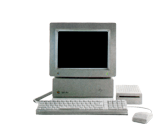I Love Pixel Art!
Quite simply, I love pixel art...truly, madly, deeply (4-bits of it to be precise).
This love affair started playing arcade games from around 1985 to 1988 and at around the same time, our family procured an Apple IIGS. I loved the near photo-realistic style of the imagery and somehow, to my mind as an impressionable pre-adolescent, this new digital imagery stood as a proud symbol of how far homo sapiens had come with technology. I didn't think they existed for any other reason than to fill my head with wonder.
Seeing these new graphics abilities became all-important and getting the most out of our IIGS involved buying up as many IIGS specific programs as fiscally possible. My first encounters involved Paintworks Plus, Tass Times in Tonetown and my all time favourite, and probably the game I've put more hours into than any other over my lifetime, the Bard's Tale. There are many tremendous examples of great pixel art into various IIGS games, but the Bard's Tale still holds up as one of the best.
![]()
Strangely however, as technology leapfrogged itself I should have marvelled at its progress and awe at the increasing bit depths and higher resolutions of computer graphics. But a lot of the time, I cringed during the 1990s as a lot of games on the PC and Mac started to use poorly scanned traditional artwork, or worse still, 3D graphics that were either pre-rendered or real time.
The aesthetic of 2D graphics always appealed far more to me, as it seemed to be closer to real art, only with less colours and a low resolution. The graphics can be executed in various different ways, allowing the artists to develop their own styles, something that can't always be said for 3D artwork - most of the time, it looks the same, attempting to create as realistic an environment as possible, but with such a limited number of polygons to simulate real life, these graphics now look laughable as the Playstation 3 and XBox 360 reign. No doubt in ten years time, the graphics of the PS3 and XBox 360 will be considered equally laughable.
For me at least, pixel art will hold up forever. Usually the best examples of design are those that still manage to work well (if not better) due to the limitations and restrictions placed upon a piece. Pixel art adheres to the same principles. A great picture is a great picture; if a great picture is made with 16 colours with a resolution of 320 x 200 pixels, well, that's a REALLY great picture.
I've also been pleasantly surprised that I'm not the only one who thinks this. I began a quest, which started after my very good friend Andrew sent me a link to Junior Senior's clip for ‘Move Your Feet', a clip lavishly produced with low-res animation created on an Amiga with Deluxe Paint. The Amiga is to Andrew what the Apple IIGS is to me.
My quest to find more contemporary pixel art became an obsession; fortunately I didn't have too far to look and found salvation at Pixel Joint.
Pixel Joint is the world's cream of the crop when it comes to laying down artwork a pixel at a time. Artists from every corner of the globe are contributing works to weekly challenges set by their peers, as well as showing works in progress and mock-screen shots for games, as well as art for art's sake.
Not long after enthusiastically pouring over these inspiring pieces of digital art did I think: I'd love to see that on the IIGS. That's what you can find here - 3 disks full of slideshows of artwork converted to the IIGS native Apple Preferred Super Hi-res format. Each piece is fully credited to each artist and their permission sought before including their work in this collection. Some works I would have loved to include didn't translate as well to the IIGS as the artist would have liked, so I removed them from the collection. If you explore Pixel Joint, you'll still find lots of great artwork which you can convert to display on your IIGS and judge for yourself as to whether you think they're still great images.
![]()
![]()
![]()
![]() Download Pixel Art Slideshows for the IIGS (1.5 meg)
Download Pixel Art Slideshows for the IIGS (1.5 meg)
Each slideshow is self-booting and runs Ron Mercer's terrific shareware program SHRView. Most of the conversions were made with Ron's other fantastic program, Prism. I did some preparation in Photoshop first however, to crop certain images to better suit the resolution limitation of the IIGS. Apologies to my old friend Ian Brumby (author of Super Convert v4.0) and to Antoine and Olivier of Brutal Deluxe (creators of Convert 3200) but I found Prism converts images very efficiently by way of a simple interface that also seemed to yield the best results. By the way, not a single piece of art has been converted to the 3200 colour mode, which I feel is too crippling to be of any practical use on the IIGS. Finally, Universe Master was used to alphabetically sort the files of the directory when played back by SHRView.
I hope you'll feel as inspired as I have seeing all this art. Who said that 16 colours per scan line was never enough? And if you've got a IIGS project in mind that requires some graphics, whether it be as expansive as a platform game or a nice icon or ‘About' dialogue box, get in touch with these artists at Pixel Joint. They'd love nothing more than the challenge of doing great art under the limitations of the IIGS...to make REALLY great art!


